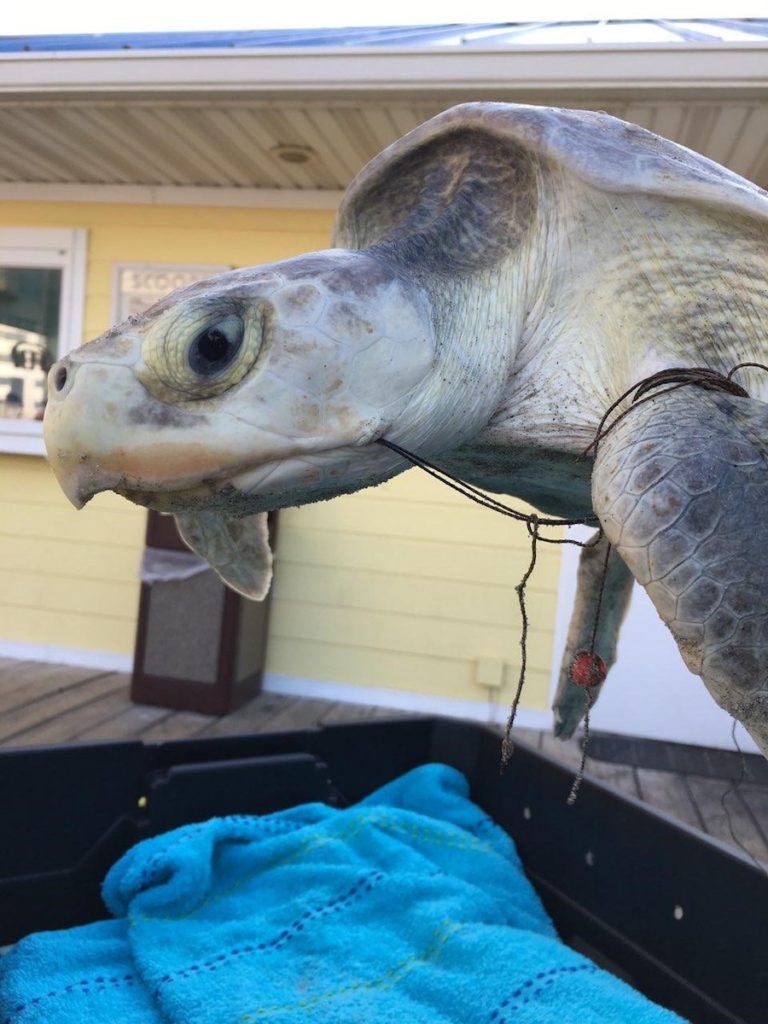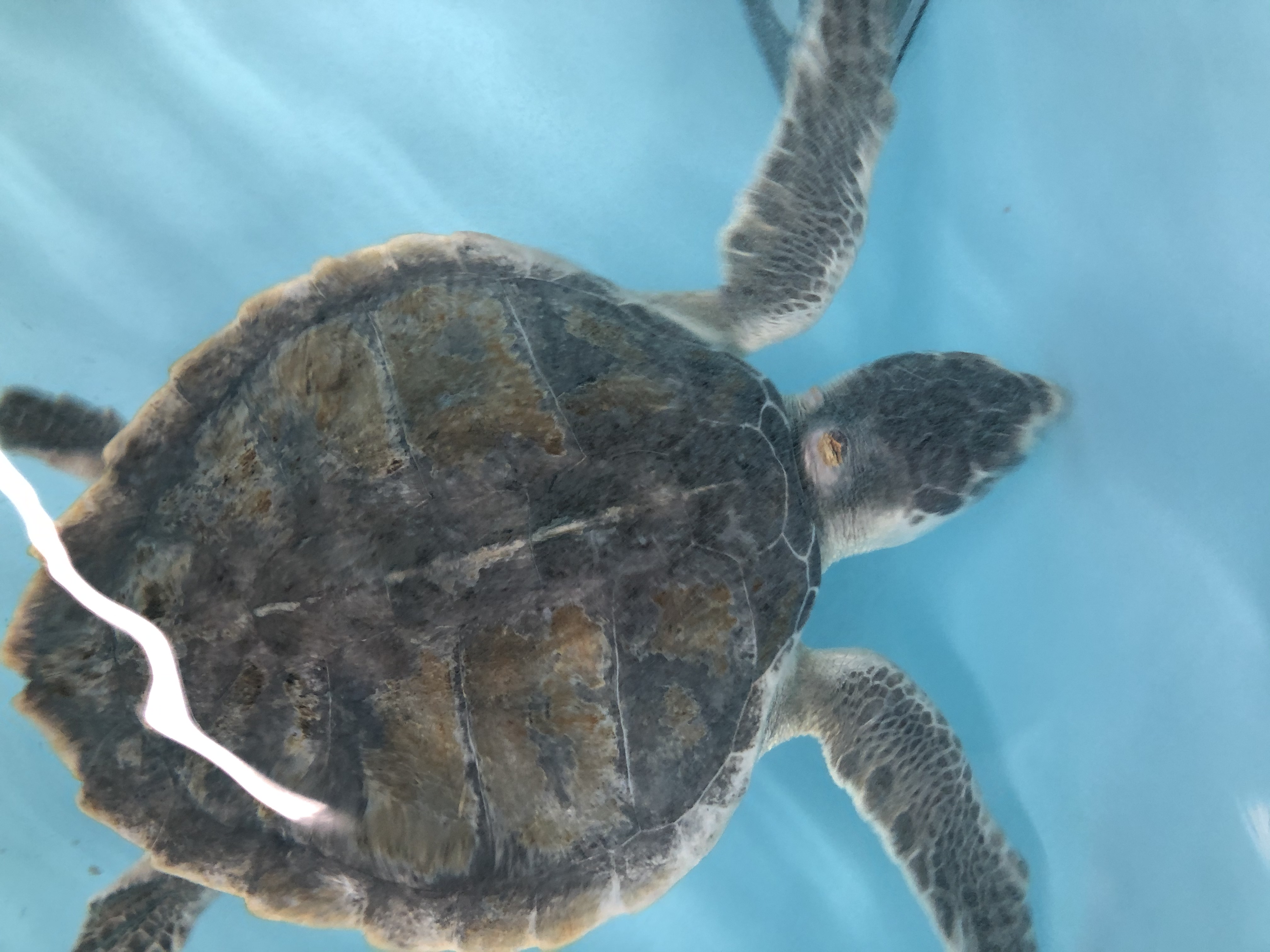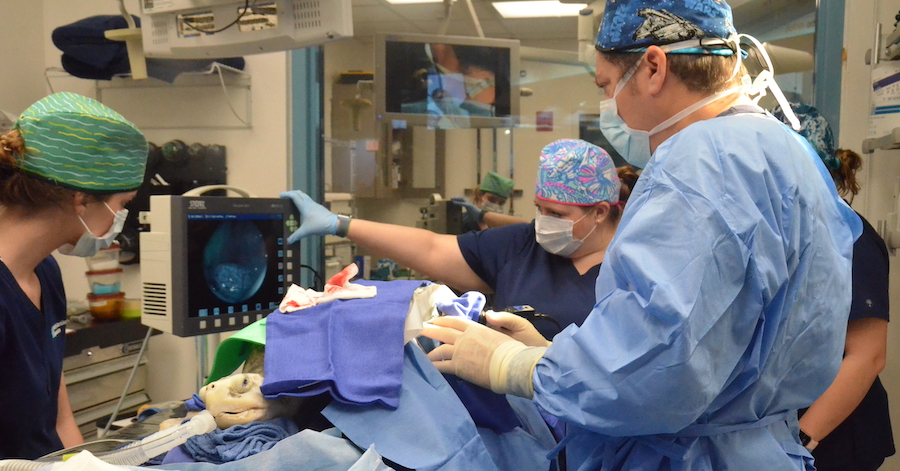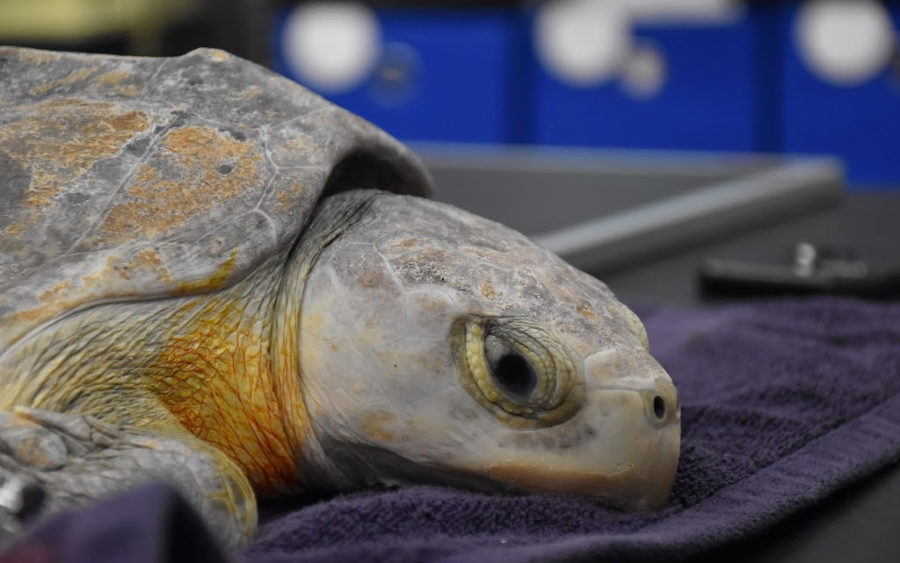Kemp’s ridley (Lepidochelys kempii)
Stranding Location: Cherry Grove Pier, Myrtle Beach, SC
Arrival Date: 8/13/2019
Age: Juvenile
Weight: 10.5 lbs
Case History
Ed was hooked by a fisherman on Tuesday, August 13, 2019. A group of women on the pier assisted in getting Ed to the beach. They saw that Ed had braided fishing line wrapped around his left front flipper. Unfortunately, the line continued into the mouth and out his cloaca, meaning it was throughout his entire body. Linda Mataya, a South Carolina Department of Natural Resources (SCDNR) transporter, responded to the call, rescued this little guy off, and transported him to the South Carolina Aquarium. Once Ed arrived, Sea Turtle Care Center staff began triaging quickly to assess the severity of situation.
Treatment
Upon admit, staff took radiographs to see if there were any hooks present in his body. Luckily, radiographs showed no hooks present, but unfortunately, braided fishing line doesn’t show up on x-rays. With the line going completely throughout his body, staff was concerned about the damage the line could be causing to his esophagus, stomach and intestines. Vet staff took a CT of Ed to better access the location of the line in his body. Ed was given some pain medication to allow him to be more comfortable and calmer during the CT. While the medications were taking effect, staff took measurements, analyzed his blood, did a full physical exam to look for any other injuries, and removed some fishing line from his left front flipper. Ed’s bloodwork was poor, and his body condition was very thin. Ed was most likely sick before getting caught on the line.
The CT image showed areas of plication, or folding, in the intestines. The pull or tension of the line moving through the intestines caused stress, and the areas under the most tension to pulled together like an accordion. Left untreated, the tissue in the plicated sections of the intestine could die or the line could tear through the intestinal wall. Ed also received an ultrasound so vet staff could take a look at his intestines, and an endoscopy to get a better view of the damage to his GI tract. A radiopaque contrast liquid, called Gastroview, was also tube fed to help highlight the view of his GI tract on additional x-rays and CT scans. Vet staff decided that surgery would be the best option to remove the monofilament line and to give him his best chance of survival. Ed was set up on a waterbed and given fluids, antibiotics, and vitamins and was left resting comfortably overnight before his big surgery day.
Updates
 August 19, 2019: The morning after admit, Ed was in surgery for several hours. Dr. Shane Boylan performed an enterotomy procedure, making several incisions to the intestines, and removed roughly 16 inches of line from Ed’s GI tract and a little more from his mouth. During surgeries, it is important to keep track of the patient’s vitals, and we began to see Ed’s heart rate drop slightly so we went ahead and closed him up and began the recovery process. The recovery process for reptiles can take several hours; we set a ventilator up to breathe for Ed overnight and had staff check on him throughout the night. The next morning Ed was responsive and put into water later that afternoon.
August 19, 2019: The morning after admit, Ed was in surgery for several hours. Dr. Shane Boylan performed an enterotomy procedure, making several incisions to the intestines, and removed roughly 16 inches of line from Ed’s GI tract and a little more from his mouth. During surgeries, it is important to keep track of the patient’s vitals, and we began to see Ed’s heart rate drop slightly so we went ahead and closed him up and began the recovery process. The recovery process for reptiles can take several hours; we set a ventilator up to breathe for Ed overnight and had staff check on him throughout the night. The next morning Ed was responsive and put into water later that afternoon.
The past few days he has become very active and swimming around constantly. We are not going to offer food because of the sutures in his intestines as well as the line that’s still in his body. He is receiving fluids and vitamins daily to help him keep his electrolytes up. Hopefully, Ed will pass the remaining line. We’re going to keep a close eye on him and potentially do another surgery next week if needed. Ed’s prognosis is guarded; there is a lot he still has to make it through before he’s in the clear. Send Ed all your positive thoughts; he’s going to need it!
September 1, 2019: Ed is overall doing well. Over the past couple weeks, he has had a couple more CT scans and several exams. We’ve recently started feeding him one squid every day. Typically, we don’t like to feed out squid because it’s almost like eating junk food; it’s not very nutritious for sea turtles. In his case, because he had surgery on his intestines, we wanted something that doesn’t have bones and is easy to digest. We’ve fed him two squids that were soaked in a contrast dye to help to visualize his intestines on CT. We’ve been able to see quite a bit from the squid! It has allowed us to see that there doesn’t appear to be any areas of complication, and it looks like some of the contrast is working its way out. We hope that means some of the line will be with it as he defecates out the contrast. Recently, Ed’s been getting one calcium-injected squid per day. The calcium will help to balance out the low nutritional value of squid. He immediately goes after the squid and slurps it up like a spaghetti noodle. He’s also receiving daily fluids and vitamins to insure he’s getting all the electrolytes and vitamins his body needs. We hope that by next week, if all goes as planned, we can start feeding him pieces of boneless fish. Ed still has a very long road ahead of him and his prognosis is guarded.
October 1, 2019: Ed has made great strides over the past month! He is on a weighted diet and is almost in a full-depth tank. He finished his extended rounds of antibiotics and has not passed any more monofilament line. It will take time for his body to fully recover due to his severe low weight when he arrived; however, it is normal for it to take a while for turtles to recover and gain weight. We are very proud of the progress Ed has made!
October 15, 2019: Ed is doing great! Staff noticed an abscess on the back on his neck which are common when an area is continuously rubbed. Since Ed is thin, his bones stick out a little more  than normal, and his neck was was rubbing against his skull. Staff cleaned Ed’s abscess, packed him full of goodies to help him heal. Since Ed was already out for an exam, vet staff decided to do a full exam, including an ultrasound, to look at his intestines to make sure there were no area of concern due to the monofilament. Staff also took an x-ray to make sure Ed’s bones were healthy. Good news, everything looked great! He has a long journey to recovery, but he’s full of fight!
than normal, and his neck was was rubbing against his skull. Staff cleaned Ed’s abscess, packed him full of goodies to help him heal. Since Ed was already out for an exam, vet staff decided to do a full exam, including an ultrasound, to look at his intestines to make sure there were no area of concern due to the monofilament. Staff also took an x-ray to make sure Ed’s bones were healthy. Good news, everything looked great! He has a long journey to recovery, but he’s full of fight!
November 1, 2019: Ed is being pulled weekly for us to monitor his weight and the abscess on the top of his neck. We are treating the abscess with silver collate, a silver-based topical dressing. Since joining us, Ed has gained two pounds, and we are happy with how far he has come!
November 15, 2019: We’ve noticed a change in Ed’s behavior recently as he hasn’t been eating. In the past, Ed was very active in his tank and ate his full diet. We’ve tried to spark his interest by offering him several different types of food, but we’ve had no luck. We recently injected a radiographic contrast called GastroView® into a squid and fed it to Ed in hopes to get a better image of his intestines. Unfortunately, a lot of the contrast diluted out before Ed could chow down, so we tube fed him the contrast to get a better image of his GI tract. Through bloodwork, we could see his white blood cell count was elevated, indicating an infection. We have started him back on antibiotics and given him supplemental fluids. The next steps for Ed will be to get him eating again and, possibly, an MRI to get a different view of his GI. We believe there is still some monofilament left inside him, and it could be causing impaction or complications in the intestines. We have started Ed back on antibiotics and gave him supplemental fluids until we can conduct the MRI to get a clear image of what’s going on inside his intestines. Since day one, this little guy has had a tough recovery, but we’re hopeful he will bounce back!
December 1, 2019: Ed received contrast, Ultrasound, CT, and surgery last week. When we viewed the CT, vet staff noticed an area of concern. The contrast showed a part of his intestines that was very enlarged and had a sharp turn in one of the loops. Although we couldn’t see any line or anything causing this, we were concerned about plication of the intestines. Plication is caused by pull or tension of line moving through the intestines. The areas under the most tension can be pulled together like an accordion. If left untreated, the tissue in the plicated sections of the intestine coulddie, or the line could tear through the intestinal wall. Since we had this concern, we wanted to conduct surgery on Ed to figure out what was causing this enlarged area. The following day, Ed went through surgery and we didn’t find any line or anything wrong. Dr. Boylan pulled as much intestines out as he could, and palpated them as far as possible. Ed’s intestines looked great and the incisions from last surgery healed wonderfully. The next concern we had was that Ed wasn’t eating, which is where all of this originally stemmed from. The day after surgery, he was put back into his tank and offered squid, which he ate immediately. The next few days we began offering fish stuffed squid and had great results from him. He’s now eating his full diet of fish again with no issues. We’re not sure why Ed went off feeding for a bit but we’re happy to say he’s currently doing much better!
incisions from last surgery healed wonderfully. The next concern we had was that Ed wasn’t eating, which is where all of this originally stemmed from. The day after surgery, he was put back into his tank and offered squid, which he ate immediately. The next few days we began offering fish stuffed squid and had great results from him. He’s now eating his full diet of fish again with no issues. We’re not sure why Ed went off feeding for a bit but we’re happy to say he’s currently doing much better!
December 15, 2019: We are happy to report that Ed has been doing much better since our last update! Ed has been eating with a ravenous appetite, and pooping up a storm, which are both good signs in his recovery. His incision site is healing up nicely and he is still receiving antibiotic injections.
January 1, 2020: Ed has really turned a corner over the last 6 weeks. Ed has continued to eat incredibly well (Ed’s still picky and will only eat mackerel or salmon), and is poopin’ it up! Though Ed has finished up her antibiotic injections, we continue to treat Ed’s neck abscess weekly to help it heal. Something interesting that we discovered about Ed during her surgery is that Ed is a female. Dr. Shane was able to see her ovaries endoscopically. Unless a patient is an adult size at admit, their sex is usually unable to be determined unless their reproductive tract is seen during an endoscopic procedure.
January 15, 2020: Earlier this week, Ed was supposed to be sedated for a debridement procedure on his neck abscess. Debridement is the process of removing infectious or foreign material from a wound in an effort to help it heal. However, when we pulled her for an exam, the abscess was visibly smaller so the treatment wasn’t needed! We think Ed was very happy about that.

February 1, 2020: Ed continues to do great! His abscess has reduced in size and it looks much better. She is gaining weight and growing a little. She has gained roughly 3 pounds and grown about a centimeter since her admit! Over the last few weeks, Ed has passed a couple fibrin pieces which is likely from the remaining damage the braided line caused inside her intestines. The scab like material will naturally slough off as she heals. As long as Ed continues to defecate normally, we don’t need to worry because her body is still healing.
February 15, 2020: Over the past week, Ed has passed several large chunks of layered fibrin after a few weeks of nothing. Even though Ed is eating well and defecating daily, the fibrin plugs are concerning. Last week, our veterinary team sedated Ed for another ultrasound and CT to better access the situation. Ultrasound and CT imaging show some areas of concern in is GI tract, so we are going to do another minimally invasive endoscopic procedure to look for what might be causing this complication.
March 1, 2020: Last week, Ed underwent another coelom endoscopy to look at his gastrointestinal track for any problematic areas that could be causing the fibrin plugs we have been finding in his fecals. During this surgery, Dr. Boylan made a small incision on Ed’s left and right inguinal areas, and an endoscope was used to view the intestines. Dr. Boylan found nothing out of the ordinary during the procedure. To help rule out a partial obstruction somewhere in Ed’s GI tract, we put BIPS (barium impregnated polyethylene spheres) in his food. BIPS are radiopaque and can be tracked, as they move through the GI tract, using x-rays. If the BIPS do not pass through a certain area, then that can help locate where the problem could be. The damage to Ed’s GI tract that was caused by the braided line was extensive, so it’s not surprising that his body is still sloughing out fibrin as it continues to heal. Ed passed all of his BIPS,  except for one that stayed in the same area for several days. We may schedule another procedure to look at Ed’s stomach and upper GI to rule out the possibility of any braided line that we may not have been able to access in previous surgeries or that may be causing complications. Ed is otherwise eating and defecating well, and is now gaining weight!
except for one that stayed in the same area for several days. We may schedule another procedure to look at Ed’s stomach and upper GI to rule out the possibility of any braided line that we may not have been able to access in previous surgeries or that may be causing complications. Ed is otherwise eating and defecating well, and is now gaining weight!
March 15, 2020: Ed has been doing well since the procedure and we’ve been feeding him BIPS (barium impregnated polyethylene spheres). We’re still observing his behavior to see if another procedure is needed to look at his stomach. Other than that, Ed’s doing great! He was recently moved up to Zucker Family Sea Turtle Recovery and has quickly become a guest favorite. Make sure to come in and see Ed!
April 1, 2020: Ed has passed more fibrin over the last couple of weeks, but is otherwise status quo. He’s one tough turtle!
April 15, 2020: Ed was out today for an examination and a weight and measurement. He looks fantastic! He has gained close to 2 pounds in the last month and has grown one whole centimeter in shell length. He has great muscle tone now and is full of energy. He has been digesting his food well and defecating regularly, so overall his checkup was great and we are pleased with his progress!
May 1, 2020: Our feisty friend Ed has been cruising through his rehab process lately. He has been eating well, gaining weight, and defecating regularly, which is a great improvement! We will continue to monitor that there are no setbacks with his digestive health, but for now everything is going smoothly.
June 1, 2020: Ed has become particularly picky about eating his vitamins in the past few weeks, but we still have a few tricks up our sleeves that we use to get him to eat them. Other than being similar to a picky toddler about medication, he is doing great!
July 15, 2020: Ed was continuing to coast through rehab when we found more fibrin in his fecal the day he got his blood drawn. Bloodwork results showed that he was slightly anemic, indicating an underlying issue. Our biggest concern throughout his rehabilitation is that we may not have gotten all the monofilament out of his gastrointestinal tract during his initial surgeries. Based on the fibrin that he has been passing, the concern is that there may be a piece of monofilament adhered to an area of the intestines that is very challenging to access surgically. We have done multiple exploratory endoscopic procedures and contrast studies on him throughout his rehab, but we could not find the source of the complications he’s been having. We decided to sedate him again, and scoped his stomach and lower GI tract to see if there were any areas of irritation or adhered line that relocated since previous procedures. Dr. Shane did not see anything abnormal, so we tube fed him GastroView®, a radio opaque liquid that highlights the GI tract on x-ray and CT scans. By doing another contrast study, we are hoping to find the cause of the fibrin. Ed’s been through so much in his time with us, and we are doing all we can do get him healthy and released back into his ocean home.
August 15, 2020: The results of the contrast study in our last update showed staff that Ed has a plication in his GI. This is an area where the intestine has twisted in on itself, likely caused by the fishing line Ed originally ingested. The area of concern likely has a spot where the irritation is causing a slow bleed to occur. This would explain the anemia as well as the periodic fibrin we find in Ed’s fecals. Ed underwent exploratory surgery to locate the plication and see what, if anything, we could do about it. The surgery resulted in no better findings than any of the others. The plication is in a location we cannot access. Since Ed is gaining weight and maintaining a good body condition, his best shot is to let him live out his life. He seems to be in no pain or have major complications from the plication, so we hope for the best for Ed as he gets closer to release.
October 15, 2020: We know it has been a while since we had an Ed update. That’s because, over the past few months, Ed has been cruising! Since his last procedure back in July, Ed has had no complications, his defecations are now normal and he has gained weight. Last week, Ed was pulled for an exam, bloodwork and he reached a major milestone: He received his P.I.T tag! Though Ed has not been medically cleared for release just yet, this means that our vet staff is considering him as a release candidate. Stay tuned for more exciting news about Ed!


